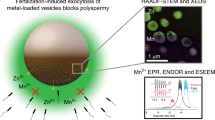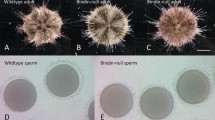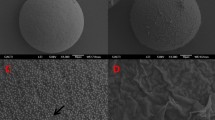Abstract
When a sperm activates a sea urchin egg at fertilization, it triggers the release of calcium from a store within the egg by a hitherto unknown mechanism1,2. The ensuing transient increase in cytoplasmic calcium concentration is the stimulus for the beginning of embryonic development3,4. Here we have activated sea urchin (Lytechinus pictus) eggs by microinjecting inositol 1,4,5-trisphosphate (InsP3), a substance which Berridge5 has suggested may be an intracellular messenger whose probable function is to release calcium from intracellular stores6–9. It is thought that InsP3 is produced from plasma membrane phosphatidylinositol 4,5-bisphosphate (PtdIns(4,5)P2) via enzymatic hydrolysis by a phospholipase C10. Recently, it has been demonstrated that there is a substantial increase in the turnover of polyphosphoinositides in the sea urchin egg at fertilization11. We now present preliminary evidence that there is a calcium-stimulated breakdown of PtdIns(4,5)P2 in the egg cortex. We believe that, just as microinjecting InsP3 stimulates an increase in cytoplasmic calcium, the production of InsP3 at fertilization may be responsible for the release of calcium from the egg's intracellular store.
This is a preview of subscription content, access via your institution
Access options
Subscribe to this journal
Receive 51 print issues and online access
$199.00 per year
only $3.90 per issue
Buy this article
- Purchase on Springer Link
- Instant access to full article PDF
Prices may be subject to local taxes which are calculated during checkout
Similar content being viewed by others
References
Chambers, E. L. & Angeloni, S. V. J. Cell Biol. 91, 181a (1981).
Whitaker, M. J. & Steinhardt, R. A. Q. Rev. Biophys. 15, 593–644 (1982).
Steinhardt, R. A. & Epel, D. Proc. natn. Acad. Sci. U.S.A. 71, 1915–1919 (1974).
Steinhardt, R. A., Zucker, R. & Schatten, G. Devl Biol. 58, 185–196 (1977).
Berridge, M. J. Biochem. J. 212, 849–858 (1983).
Streb, H., Irvine, R. F., Berridge, M. J. & Schultz, I. Nature 306, 67–68 (1983).
Burgess, G. M. et al. Nature 309, 63–66 (1984).
Joseph, S. K., Thomas, A. P., Williams, R. J., Irvine, R. F. & Williamson, J. R. J. biol. Chem. 259, 3077–3081 (1984).
Prentki, M. et al. Nature 309, 562–564 (1984).
Irvine, R. F., Letcher, A. J. & Dawson, R. M. C. Biochem. J. 218, 177–185 (1984).
Turner, P. B., Sheetz, M. & Jaffe, L. A. Nature 310, 414–415 (1984).
Baker, P. F. & Whitaker, M. J. Nature 276, 513–515 (1978).
Whitaker, M. J. & Baker, P. F. Proc. R. Soc. B 218, 397–413 (1983).
Moser, F. J. exp. Zool. 80, 423–445 (1939).
Allen, R. D. Expl Cell Res. 6, 403–424 (1954).
Jaffe, L. F. Devl Biol. 99, 265–276 (1983).
Shen, S. S. & Steinhardt, R. A. Nature 272, 253–254 (1978).
Whitaker, M. J. & Steinhardt, R. A. Cell 25, 95–103 (1981).
Ehrenstein, G., Defelice, L. J. & Dale, B. Biophys. J. 45, 23a (1984).
Hamaguchi, Y. & Hiramoto, Y. Expl Cell Res. 134, 171–179 (1981).
Irvine, R. F., Brown, K. D. & Berridge, M. J. Biochem. J. 222, 269–272 (1984).
Crank, J. The Mathematics of Diffusion (Oxford University Press, 1975).
Mannhertz, H. G. Pflügers Archges. Physiol. 303, 230–248 (1968).
Seiffert, B. & Agranooff, B. W, B. W. Biochim. biophys. Acta 98, 574–581 (1964).
Jolles, J., Zwiers, H., Dekker, A., Wurtz, K. W. A. & Gispen, W. H. Biochem. J. 194, 283–291 (1981).
Author information
Authors and Affiliations
Rights and permissions
About this article
Cite this article
Whitaker, M., Irvine, R. Inositol 1,4,5-trisphosphate microinjection activates sea urchin eggs. Nature 312, 636–639 (1984). https://doi.org/10.1038/312636a0
Received:
Accepted:
Issue Date:
DOI: https://doi.org/10.1038/312636a0
This article is cited by
-
Actin, more than just a housekeeping protein at the scene of fertilization
Science China Life Sciences (2011)
-
The NAADP receptor: commentary on Billington et al.
British Journal of Pharmacology (2004)
-
Cyclic ADP-ribose and the regulation of calcium-induced calcium release in eggs and cardiac myocytes
Cell Biochemistry and Biophysics (1998)
-
Calcium oscillations in mammalian eggs triggered by a soluble sperm protein
Nature (1996)
Comments
By submitting a comment you agree to abide by our Terms and Community Guidelines. If you find something abusive or that does not comply with our terms or guidelines please flag it as inappropriate.



